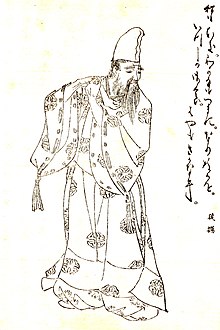| Senior First RankFujiwara no Saneyori 藤原 実頼 | |
|---|---|
 Illustration by Kikuchi Yōsai, from Zenken Kojitsu Illustration by Kikuchi Yōsai, from Zenken Kojitsu | |
| Imperial Regent of Japan | |
| In office 31 July 967 – 24 June 970 | |
| Monarchs | Reizei En'yū |
| Preceded by | Fujiwara no Tadahira |
| Succeeded by | Fujiwara no Koretada |
| Personal details | |
| Born | 900 |
| Died | 24 June 970(970-06-24) (aged 69–70) Heian Kyō (Kyōto) |
| Parent(s) | Fujiwara no Tadahira (father) Minamoto no Junshi (mother) |
Fujiwara no Saneyori (藤原 実頼, 900 – 24 June 970), also known as Onomiya-dono, was a Japanese statesman, courtier and politician during the Heian period.
Career
He was a minister during the reigns of Emperor Reizei and Emperor En'yū.
- 2 May 944 (Tengyō 7, 7th day of the 4th month): Saneyori was elevated to the position of udaijin in the Imperial court hierarchy.
- 19 May 947 (Tenryaku 1, 26th day of the 4th month): Saneyori is promoted to the positions of sadaijin and grand general of the left.
- 949 (Tenryaku 3, 1st month): Saneyori and his brother Morosuke shared the duties of daijō-daijin during a period of Fujiwara no Tadahira's ill-health.
- 958 (Tentoku 2, 3rd month): Saneyori was granted special permission to travel in a wheeled vehicle.
- 26 March 963 (Ōwa 3, 28th day of the 2nd month): Saneyori presided at the coming of age ceremonies for Norihira-shinnō (憲平親王) who would later become Emperor Reizei.
- 31 July 967 (Kōhō 4, 22nd day of the 6th month): Saneyori began serving as kampaku when Emperor Reizei assumed the throne in 967.
- 27 September 969 (Anna 2, 13th day of the 8th month): Saneyori was appointed sesshō (regent).
- 24 June 970 (Tenroku 1, 18th day of the 5th month): Saneyori died at age 70; and he was posthumously elevated to the first class in rank.
After his death, Saneyori's nephew Koretada assumed his duties when he was named sesshō after his death.
Genealogy
This member of the Fujiwara clan was the son of Fujiwara no Tadahira. Saneyori was the eldest son. He had two brothers: Morosuke and Morotada.
Notes
- ^ Nussbaum, Louis-Frédéric. (2005). "Fujiwara no Saneyori" in Japan Encyclopedia, p. 208, p. 208, at Google Books; Brinkley, Frank et al. (1915). A History of the Japanese People from the Earliest Times to the End of the Meiji Era, pp. 203, 259., p. 203, at Google Books
- ^ Titsingh, Isaac. (1834). Annales des empereurs du japon, p. 138, p. 138, at Google Books; see "Fousiwara-no Sane yori", pre-Hepburn romanization
- ^ Titsingh, p. 139, p. 139, at Google Books.
- Titsingh, p. 140, p. 140, at Google Books.
- Titsingh, p. 141, p. 141, at Google Books.
- Titsingh, p. 144, p. 144, at Google Books.
- Brinkley, p. 259, p. 259, at Google Books; Titsingh, p. 144., p. 144, at Google Books
- Brinkley, p. 257, p. 257, at Google Books.
References
- Brinkley, Frank and Dairoku Kikuchi. (1915). A History of the Japanese People from the Earliest Times to the End of the Meiji Era. New York: Encyclopædia Britannica. OCLC 413099
- Nussbaum, Louis-Frédéric and Käthe Roth. (2005). Japan encyclopedia. Cambridge: Harvard University Press. ISBN 978-0-674-01753-5; OCLC 58053128
- Titsingh, Isaac. (1834). Nihon Odai Ichiran; ou, Annales des empereurs du Japon. Paris: Royal Asiatic Society, Oriental Translation Fund of Great Britain and Ireland. OCLC 5850691
| Fujiwara family tree | |
|---|---|
Notes
|
| Daijō-daijin | |||||
|---|---|---|---|---|---|
| Hakuhō period | |||||
| Nara period | |||||
| Heian period |
| ||||
| Kamakura period |
| ||||
| Nanboku-chō period |
| ||||
| Muromachi period | |||||
| Sengoku period | |||||
| Azuchi–Momoyama period | |||||
| Edo period | |||||
| Meiji period | |||||
| : official court titles for samurai (buke-kan'i). | |||||